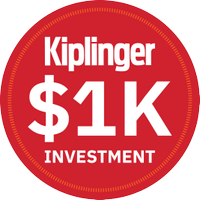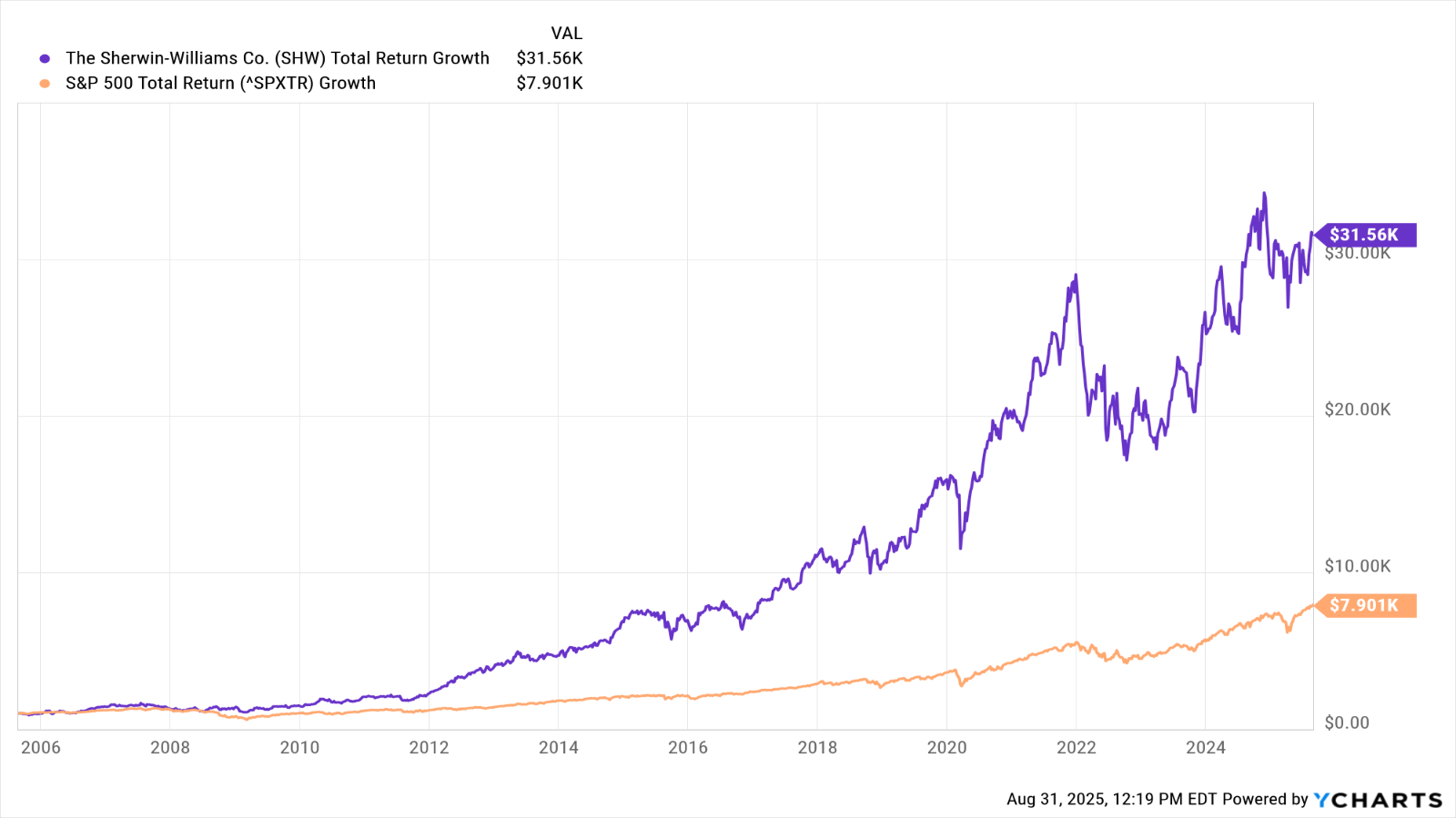If You'd Put $1,000 Into Sherwin-Williams Stock 20 Years Ago, Here's What You'd Have Today
Sherwin-Williams stock has clobbered the broader market by a wide margin for a long time.



Tech stocks might get the glory but long-term market beaters can be found in all sorts of places – even the oft-overlooked materials sector. Just take a gander at Sherwin-Williams (SHW).
Believe it or not, shares in the world's largest paint and coatings company by revenue have been an outstanding buy-and-hold bet for a very long time.
Founded shortly after the Civil War, Sherwin-Williams went on to grow rapidly, especially throughout the 20th century. But it really hit its stride in the 1980s. That's when a massive expansion of its retail base helped it become as familiar to consumers and do-it-yourself types as enterprise customers and professional contractors.
From just $107.88 $24.99 for Kiplinger Personal Finance
Become a smarter, better informed investor. Subscribe from just $107.88 $24.99, plus get up to 4 Special Issues

Sign up for Kiplinger’s Free Newsletters
Profit and prosper with the best of expert advice on investing, taxes, retirement, personal finance and more - straight to your e-mail.
Profit and prosper with the best of expert advice - straight to your e-mail.
However, it's really been over the past couple of decades that SHW became the blue chip stock that it is today. A slew of acquisitions, capped by its $11 billion deal for Valspar in 2017, massively boosted the company's portfolio – and, more importantly, its profitability.
Today, SHW is the largest U.S. manufacturer and distributor of paints, coatings and related products, with more than 5,400 retail stores in over 120 countries.
To get a sense of how SHW's economies of scale impacted its bottom line: a company that posted operating margins of around 14% prior to the Valspar deal now averages closer to 19%. Indeed, over the past five years, revenue grew 26%, while adjusted operating margin increased 31%.
True, Sherwin-Williams' end markets are highly cyclical, with construction, housing and manufacturing all being sensitive to economic growth and interest rates. Thankfully, a strong commitment to returning cash to shareholders through stock buybacks and dividends helps cushion any ups and downs.
By the way, SHW happens to be one of the best dividend stocks for dependable dividend growth, having increased its payout annually for nearly 50 years.
If there were any doubts about SHW's blue-chip bona fides, they were laid to rest when the stock was added to the Dow Jones Industrial Average in late 2024. Happily for current shareholders, Sherwin-Williams routinely ranks among analysts' top Dow Jones stocks.
The bottom line on Sherwin-Williams stock?
Sherwin-Williams is cyclical. With a beta of more than 1.0, it tends to outperform the S&P 500 in up markets and underperform in down markets. Nevertheless, over most standardized time frames this old economy stalwart has been a winner.
For its entire life as a publicly traded company, SHW has generated an annualized total return (price change plus dividends) of 17%. That beats the S&P 500 by a wide margin, or more than 6 percentage points. SHW also outperforms the market handsomely over the past 10- and 15-year periods.
The more recent past has been a bit tougher, with higher interest rates and other macro factors acting as a drag on the sector. Go back a couple of decades, however, and Sherwin-Williams stock has been a market-beating machine.

As you can see in the above chart, if you put $1,000 into SHW stock 20 years ago, it would today be worth more than $31,000. The same sum invested in the S&P 500 over the same span would theoretically be worth $7,900.
In good news for shareholders and would-be shareholders, Wall Street mostly sees more market-beating returns ahead.
Of the 27 analysts covering SHW surveyed by S&P Global Market Intelligence, 12 call it a Strong Buy, three say Buy, 11 have it at Hold and one rates it at Strong Sell. That works out to a consensus recommendation of Buy, albeit with somewhat mixed conviction.
Speaking for the bulls, Argus Research analyst Alexandra Yates calls the stock a "core long-term holding in the materials sector" based on its leading positions in high-growth end markets.
"We believe that interest rate cuts and moderating inflation will provide a meaningful rebound in real estate demand and serve as a positive catalyst," writes Yates.
More Stocks of the Past 20 Years
- If You'd Put $1,000 Into Netflix Stock 20 Years Ago, Here's What You'd Have Today
- If You'd Put $1,000 Into Microsoft Stock 20 Years Ago, Here's What You'd Have Today
- If You'd Put $1,000 Into Apple Stock 20 Years Ago, Here's What You'd Have Today
Profit and prosper with the best of Kiplinger's advice on investing, taxes, retirement, personal finance and much more. Delivered daily. Enter your email in the box and click Sign Me Up.

Dan Burrows is Kiplinger's senior investing writer, having joined the publication full time in 2016.
A long-time financial journalist, Dan is a veteran of MarketWatch, CBS MoneyWatch, SmartMoney, InvestorPlace, DailyFinance and other tier 1 national publications. He has written for The Wall Street Journal, Bloomberg and Consumer Reports and his stories have appeared in the New York Daily News, the San Jose Mercury News and Investor's Business Daily, among many other outlets. As a senior writer at AOL's DailyFinance, Dan reported market news from the floor of the New York Stock Exchange.
Once upon a time – before his days as a financial reporter and assistant financial editor at legendary fashion trade paper Women's Wear Daily – Dan worked for Spy magazine, scribbled away at Time Inc. and contributed to Maxim magazine back when lad mags were a thing. He's also written for Esquire magazine's Dubious Achievements Awards.
In his current role at Kiplinger, Dan writes about markets and macroeconomics.
Dan holds a bachelor's degree from Oberlin College and a master's degree from Columbia University.
Disclosure: Dan does not trade individual stocks or securities. He is eternally long the U.S equity market, primarily through tax-advantaged accounts.
-
 I'm want to give my 3 grandkids $5K each for Christmas.
I'm want to give my 3 grandkids $5K each for Christmas.You're comfortably retired and want to give your grandkids a big Christmas check, but their parents are worried they might spend it all. We ask the pros for help.
-
 If You're Not Doing Roth Conversions, You Need to Read This
If You're Not Doing Roth Conversions, You Need to Read ThisRoth conversions and other Roth strategies can be complex, but don't dismiss these tax planning tools outright. They could really work for you and your heirs.
-
 Could Traditional Retirement Expectations Be Killing Us?
Could Traditional Retirement Expectations Be Killing Us?A retirement psychologist makes the case: A fulfilling retirement begins with a blueprint for living, rather than simply the accumulation of a large nest egg.
-
 I'm a Financial Planner: If You're Not Doing Roth Conversions, You Need to Read This
I'm a Financial Planner: If You're Not Doing Roth Conversions, You Need to Read ThisRoth conversions and other Roth strategies can be complex, but don't dismiss these tax planning tools outright. They could really work for you and your heirs.
-
 Could Traditional Retirement Expectations Be Killing Us? A Retirement Psychologist Makes the Case
Could Traditional Retirement Expectations Be Killing Us? A Retirement Psychologist Makes the CaseA retirement psychologist makes the case: A fulfilling retirement begins with a blueprint for living, rather than simply the accumulation of a large nest egg.
-
 I'm a Financial Adviser: This Is How You Can Adapt to Social Security Uncertainty
I'm a Financial Adviser: This Is How You Can Adapt to Social Security UncertaintyRather than letting the unknowns make you anxious, focus on building a flexible income strategy that can adapt to possible future Social Security changes.
-
 I'm a Financial Planner for Millionaires: Here's How to Give Your Kids Cash Gifts Without Triggering IRS Paperwork
I'm a Financial Planner for Millionaires: Here's How to Give Your Kids Cash Gifts Without Triggering IRS PaperworkMost people can gift large sums without paying tax or filing a return, especially by structuring gifts across two tax years or splitting gifts with a spouse.
-
 'Boomer Candy' Investments Might Seem Sweet, But They Can Have a Sour Aftertaste
'Boomer Candy' Investments Might Seem Sweet, But They Can Have a Sour AftertasteProducts such as index annuities, structured notes and buffered ETFs might seem appealing, but sometimes they can rob you of flexibility and trap your capital.
-
 AI Stocks Lead Nasdaq's 398-Point Nosedive: Stock Market Today
AI Stocks Lead Nasdaq's 398-Point Nosedive: Stock Market TodayThe major stock market indexes do not yet reflect the bullish tendencies of sector rotation and broadening participation.
-
 Got $100 to Gamble? These Penny Stocks Could Be Worth the Ride
Got $100 to Gamble? These Penny Stocks Could Be Worth the RideVolatile penny stocks are high-risk plays with potentially high rewards. If you have $100 you can afford to lose, these three names are worth a look.
-
 Quick Question: Are You Planning for a 20-Year Retirement or a 30-Year Retirement?
Quick Question: Are You Planning for a 20-Year Retirement or a 30-Year Retirement?You probably should be planning for a much longer retirement than you are. To avoid running out of retirement savings, you really need to make a plan.